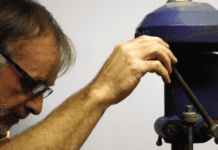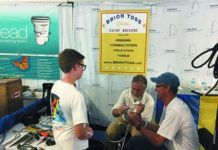Although there seems to be a new chart plotting tool every year or so, we don’t get too excited.
We were raised and trained on good old parallel rules, with a sharp pencil and a folded piece of paper to transfer distances from scales or the chart border. There was a time when we favored an even simpler approach: A pair of common drafting triangles, 45 or 30-60, no matter.
One of our specie deviated from such antediluvian ways and became adept with the parallel rolling plotter, even progressing to the Plath Bi-Rola, which rolls in two directions, has a protractor arm, a Loran interpolator, speed/time/distance tables, etc. He also carried aboard an impressive-looking aircraft plotter to calculate leeway, which the gadget thought should be called drift.
Now in hand is the very latest gadget. Brand new, its called the Navy Point. Its sort of a two-arm protractor that can be locked at 90. For those pilots who regularly use GPS or Loran, the Navy Point would be useful.
In operation, you align the unmarked arm (the other has inches marked as 0, 1/2, 1, 1-1/2, 2, etc.) of the Navy Point with a meridian (also known as a line of longitude). It can be any meridian, but youd soon learn which ones were the easiest. And you must, of course, have N in the proper place.
Then, one hand holding, the other sliding, you simply move the whole shemolean, still locked at 90, one arm for up and down, the other side-to-side, to a position where the arms can reach the latitude and longitude figures (supplied to you by your GPS) on the edges of charts. When matched up, drop a pencil through the circular hinge and that dot is where you be. It takes a bit of a knack, but perhaps no more than parallel rules.
The Navy Point also can be used somewhat like parallel rules to lay out and measure courses. If aligned carefully with the magnetic compass rose on inland and coastal charts, it can lay out magnetic courses.
Because the arms (which are easily demounted for use as straightedges) are 19-1/2″ long, youd need a fairly big chart table (and some practice) to make good use of this interesting gadget. Its a tight squeeze on the BBA Chart Kits, which are 17″ x 22″.
The Navy Point is offered at $49.95 list. (Simpson Lawrence USA, 6208 28th Street East, Bradenton, FL 34203-4123; 800/846-3527.)
Sea Fan-Practical Wind Scoop
In the marine world, something pops up occasionally, just once in a while, mind you, thats not only good but cheap. It provides a rush of pleasure, sort of like finding while testing a bunch of gear that the best one isn’t the most expensive. Doesnt happen often. Not here, either.
The Sea Fan is a flexible piece of molded polypropylene shaped a bit like a fan. When the thing is curled up, flanges on two edges slip in and clamp securely inside the outer frame of an open portlight. When in place, it makes a fairly large and surprisingly effective wind scoop. It works best, of course, when at anchor. If docked, the direction of the wind could nullify the ventilating effect. And, of course, one might go overboard if snagged by an errant foot making its way aft along the side deck. However, the Sea Fan floats…and, being flat, is easy to stow.
Two of these gadgets on a 27-footer or four of them on a boat with enough portlights would move an appreciable amount of air-as long as theres a breeze. If your portlights permit, Sea Fans can be used when its raining (but not pouring or blowing hard).
The inventors are John Tomasko and Matthew DeGiglio, a couple of New Jersey sailors, whose third partner is Richard Palmeiri.
The Sea Fan vents are available for $19.95 each, $4.95 for shipping and handling. That seems outrageous for a 13″ x 15″ piece of plastic. (New Latitudes, Inc., 166 Prospect, North Arlington, NJ 07031; 201/955-0668.)
SnugSak Sleeping Bag
Remember Aaron Feuerstein? Hes the fabric maker in Lawrence, Massachusetts who acquired national fame when, after a 1995 fire, he continued to pay his workers while rebuilding his Malden Mills. Polartec is Maldens big seller.
Paul DiMartino, who runs a big canvas shop, uses Polartec to make fender covers, blankets and pillows. But the best use hes found for Feuersteins soft, thick pile fabric is for sleeping bags. He calls them SnugSaks.
He concedes theyre not the ticket for wintering over in Nome, but aboard a boat in summertime, he thinks theyre perfect. A SnugSak is very light and, because it rolls up very small, stows easily in the supplied nylon draw-string bag.
Perhaps the biggest advantage is that, unlike conventional sleeping bags (we had one called Whew!), they launder beautifully and dry quickly.
SnugSaks come in two sizes. They can be zippered together. The adult version (78″ x 30″) sells for $75, two for $130. The childs (60″ x 22″) is $60. (S & S Fabric Products, One Maritime Drive, Portsmouth, RI 02871; 401/683-5858.)
Bobbin Replacement Offer
Because there was a potential problem with some Halkey-Roberts bobbins used in inflatable life vests, the St. Petersburg, Florida company has issued an offer to replace any made before August, 1997.
The companys new bobbins, made and tested to an upgraded quality threshold, will be supplied free of charge.
Because they are used in safety equipment, the company decided in favor of the free replacement program, even though a company spokesman said that the chances of any individual bobbin being faulty are extremely small.
A bobbin is a honey-combed doughnut of paper that holds in place a ring of plastic fingers that restrain a spring-loaded trigger. When wet, the paper quickly compresses enough to let the trigger force its way past the plastic fingers and pierce the CO2 cartridge.
Having tested over the years a lot of inflatable equipment equipped with Halkey-Roberts bobbins, we do not disagree with the company statement; weve never known a bobbin to fail to perform its designated function. (All such equipment we know of also can be triggered manually by jerking a cord or, as a last resort, orally.) Nevertheless, it behooves owners of inflatable life vests to replace any bobbin bearing a clearly marked date prior to August 1997.
Inflatable manufacturers all recommend that the bobbin be replaced annually. Because weve always advocated trying out safety equipment, we think its a good idea to set off the old one; inspect everything; clean and dry all components; replace both the bobbin and the CO2 cartridge, and repack.
Replacements for the pre-08/97 Halkey-Roberts bobbins are available from dealers, life vest manufacturers or by calling 800/303-4384.
Calendar of Wooden Boats
If you didn’t get a 1998 calendar for Christmas, fork over $14.50 plus $3 shipping for the latest 12 images of wooden boats from Benjamin Mendlowitz. This year’s selection includes the Maine coasting schooner Nathaniel Bowditch, a Herreshoff ketch, Great South Bay catboat, Hacker runabout and a San Francisco harbor tug. With Mendlowitz behind the lense, color sets the mood, always rich and soft, fitting the subject matter superbly. A perennial favorite of ours.
New this year, Mendlowitz has a computer screen saver and wallpaper that works with Windows 3.1 or Macintosh System 7.1 or later. We loved ours until we discovered it was causing occasional crashes while running Pagemaker. Price is $17.95 plus $3 shipping. (Noah Publications, PO Box 14, Reach Rd., Brooklin, ME 04616; 207/359-2131.



































